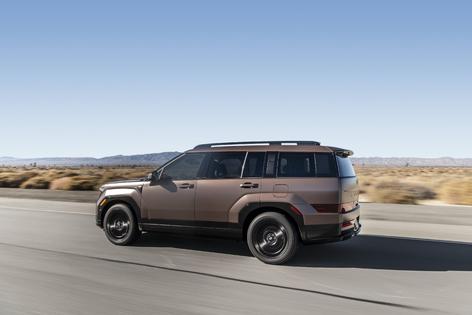Eric's Autos: 2025 Hyundai Santa Fe Hybrid
Mr. T used to say, "I pity the fool." Let's add to that the one who must -- somehow -- design their crossover to stand out from all the other crossovers.
Well, one way to do that is to design it differently -- at least visually -- and that's what Hyundai did with the Santa Fe. It looks very much unlike all the other crossovers.
And more like a futuristic Range Rover.
What It Is
The Santa Fe is a midsize crossover with three rows and room for six or seven people, depending on the configuration. It is available with either a convention gas-engine drivetrain or a hybrid drivetrain, which can save you about 16 mpg in city driving. It is also available in a more SUV-ish XRT trim that has more ground clearance and towing capacity than the other trims. But it's how the Santa Fe looks that makes it stand out. The sleek, slab-sided exterior is strikingly distinctive, which will appeal to people who want a midsize, three-row crossover -- just not one that looks like every other crossover.
Prices start at $34,300 for the base trim SE, which comes standard with a turbocharged 2.5-liter engine paired up with an eight-speed automatic and front-wheel drive. Adding the optional all-wheel drive bumps the MSRP up to $36,100. A hands-free liftgate, LED headlights and a 12.3-inch touch screen are standard.
The $36,800 SEL adds a single-sheet panorama display that integrates the main instrument cluster with the interface for the secondary systems and apps, synthetic leather seats with heaters for the driver and front-seat passenger, and a digital key that lets you use your phone to access the vehicle and control certain functions. AWD bumps the price up to $38,600.
The XRT ($40,950) comes standard with AWD and 1.3 inches more ground clearance as well as a set of 18-inch wheels with all-terrain tires. A sunroof and GPS navigation are also included.
The Limited ($43,700) gets a larger panorama sunroof, real leather, heated rear seats (and steering wheel plus an upgraded 12-speaker Bose audio system. AWD bumps the price of this trim to $45,500.
The Caligraphy trim ($46,850) is the most luxurious version of the Santa Fe. It comes with everything that's standard in the lower trims, plus quilted leather seats, suede headliner, power-folding second-row captain's chairs, dual wireless phone chargers and 21-inch wheels.
There is also a hybrid version of the Santa Fe, which will be the focus of this review. It is offered in SEL ($37,800), Limited ($44,700) and top-of-the-line Caligraphy trims ($47,850), all of which are available with AWD but come standard with FWD. In these models, the 2.5-liter gas engine is replaced by a 1.6-liter gas engine paired with a hybrid system that keeps the gas engine off as often as possible to boost gas mileage.
A six-speed automatic is standard with the hybrid SF.
What's New For 2025
The restyled SF made its debut last year (2024), so the changes for this year are few beyond the addition of a new color -- Atlantis Blue.
What's Good
-- Striking looks assure this crossover stands out from the crowd.
-- Excellent fuel economy from the hybrid, which also isn't extravagantly expensive to buy.
-- Hybrid's standard transmission is not a continuously variable transmission.
What's Not So Good
-- The hybrid would be less expensive to buy if Hyundai offered it in the base SE trim.
-- Hybrid's max tow rating is just 2,000 pounds. Significantly below the 3,500-pound rating of the nonhybrid models and less than half the 4,500-pound max tow rating of the XRT trim.
-- All-LCD panel doesn't look distinctive because everything else has one of those too.
Under the Hood
The nonhybrid Santa Fe comes standard with a turbocharged 2.5-liter four-cylinder engine that touts 277 horsepower and 311 foot-pounds of torque.
Hyundai also offers a hybrid drivetrain that replaces the 2.5-liter four with an even smaller 1.6-liter four, supplemented by an electric motor for on-demand power and a battery pack that powers accessories when the engine isn't running. The engine also powers up the battery, completing the circle. Total maximum output of this drivetrain is 231 horsepower and 271 foot-pounds of torque, which is sufficient to get this version of the SF to 60 mph in about 7.8 seconds.
That's obviously a couple steps behind the nonhybrid SF, but what you get in exchange is much better gas mileage -- and driving range. The hybrid SF touts 36 mpg in city driving and 35 mpg on the highway. That works out to about 35 mpg overall versus about 25 mpg overall for the nonhybrid SF, which is a big difference in everyday cost-to-drive savings.
On the Road
The tested Sante Fe hybrid's main selling point -- other than its different-than-other-crossover looks -- is gas mileage, but Hyundai also ought to make more noise about the driving range.
Especially in stop-and-go city driving.
Being able to drive more than 600 miles between stops isn't just about saving gas money; it is about saving time. Electric vehicles waste it, no matter how you look at it. Yes, you can charge at home. But you're still having to spend time there, right? Maybe you are able to do something else -- such as sleep. But the fact remains: You're spending time waiting to be able to drive again.
The hybrid drivetrain is especially good at buying you time in stop-and-go "city" driving because when you're not moving (or moving slowly) the engine usually isn't running, and so it isn't using any gas -- and the less you use, the more time you have before the next fill-up.
At the Curb
The SF -- standard and hybrid -- is midsize and comes standard with a third row. What that means is that while it does have more room for passengers than a two-row crossover, there's not much room in the third row. That's kind of the bargain or -- more precisely -- the compromise. A midsize crossover like the SF is made to appeal to people who need a third row but don't want a full-size crossover.
The SF's third row is fine for kids, who can easily crawl back there, and it's a fine place to toss a gym bag or other such things when you've got passengers in the second row. With the third row in use, there's still just shy of 15 cubic feet of cargo capacity behind the third row, which is comparable to the trunk space you'd have available in a current midsize sedan. Fold the third and second rows down and the available cargo-carrying space opens up to 79.9 cubic feet.
Of course, other midsize/three-row crossovers tout very similar versatility. What they lack is the visibility the SF comes standard with. It does not look like all the rest of them, and that is what really sells this crossover. The view from the rear is particularly striking in that is so unlike the view you see when you roll up behind just about anything else. Whether one likes how it looks is of course a matter of opinion, but there is no denying it does not look the same.
The Rest
One of the odd things about many hybrids -- and this one is no exception -- is that in order to get it, you have to step up a trim. You can get into a nonhybrid SF for $34,300, but to get into a hybrid SF, you must step up to the SEL trim, which is already $2,500 more expensive (in nonhybrid form) than the SE nonhybrid. The hybrid SEL stickers fort $37,800 -- which means it costs $3,500 more versus the nonhybrid SE. You do get the larger LCD display, synthetic leather upholstery and heated seats, all of which are nice to have. But the cost bump eats away at the gas savings of the hybrid drivetrain.
It's possible Hyundai would be able to sell more hybrid SFs if they only cost $1,000 more (to start) than the nonhybrid base trim SF.
The Bottom Line
It's not so much whether looks can kill -- but whether they'll sell.
========
Eric's latest book, "Doomed: Good Cars Gone Wrong!" will be available soon. To find out more about Eric and read his past columns, please visit the Creators Syndicate webpage at www.creators.com.
Copyright 2025 Creators Syndicate, Inc.








Comments